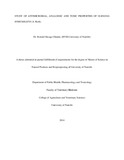| dc.identifier.citation | Okindo,R.O.,2014.Study Of Antimicrobial, Analgesic And Toxic Properties Of Vernonia Hymenolepis (a. Rich),A thesis submitted in partial fulfillment of requirements for the degree of Master of Science in Natural Products and Bioprospecting of University of Nairobi. Department of Public Health, Pharmacology and Toxicology Faculty of Veterinary Medicine College of Agriculture and Veterinary Sciences University of Nairobi. | en_US |
| dc.description.abstract | Traditional medicines have been used since ancient time for treatment of various ailments including dental diseases. Inadequacy of dental facilities and high cost of modern treatment has resulted to increased use of alternative forms of treatment. Vernonia hymenolepis is a species in the genus Vernonia that has widely been used traditionally by herbalist and communities in Trans Nzoia County for treatment of various infections including toothache. However the plants pharmacological and toxicology efficacy has not been adequately established. The aim of the study is to evaluate the antimicrobial, analgesic properties and toxicity of Vernonia hymenolepis leaves in order to elucidate its use for the treatment of toothache. Leaves of Vernonia hymenolepis were collected from Trans Nzoia County, Kenya and identified at the University of Nairobi Herbarium in the Department of Botany School of Biological Sciences and voucher specimens deposited (RO2011/001). It was shade dried, ground and organic and water extraction carried out. Antimicrobial test was done to determine minimum inhibitory concentration against standard bacteria culture Staphylococcus aureus (ATCC 25923), Pseudomonas aeruginosa (ATCC 27853), Escherichia coli (ATCC 25922), Bacillus cereus (ATCC 11778) and Candida albicans, using standard microbial techniques. Analgesic property at a dose of 100 mg/kg was determined using formalin test. Cytotoxicity of the plant extracts were determined by use of Brine Shrimp lethality test with the concentration of 10-1000 ppm. The lethal concentration (LC50) was determined using Finney computer program. The Acute Oral Toxicity Testing was performed as described by the Organization for Economic Co-operation and Development (OECD) guideline. Aqueous extract and dichloromethane /methanol extract yielded 32% in powder form and 21.5% in paste form respectively. Aqueous extract was inhibitory to only Staphylococcus aureus at dose of 400 mg/ml of plant extract. While DCM/M extract had inhibitory effect against Staphylococcus aureus at a dose of 100 mg/ml, Pseudomonas aeruginosa and Escherichia coli both at a dose of 400 mg/ ml and Bacillus cereus at a dose of 200 mg/ml.
The plant extracts showed antinociceptive activities for early phase of aqueous p< 0.0005 and organic extract p< 0.05, while the late phase of both extracts had p< 0.01. It significantly reduced the time spent in pain behavior in both the early phase (56.92 ± 7.013s verses 143.75± 11.9s control) and late phase (32.33± 1.97s verses 84±3.19s control) for aqueous extract compared to early phase (74.33±19.4 verses 111.17 ±11.4) and in late phase (9.907±1.59 verses 62±17.91s control) for dichloromathane/methanol extract of formalin test. Both the organic and aqueous extracts were in category 5 of Global Harmonization System GHS (>2000-5000 mg/kg b.w.t) of acute oral toxic class method with LD50 of 2500 mg/ml and thus not toxic at the dose of 2500 mg/ml. Dichloromethane: methanol extract (1:1) had (LC50) of 482 μg/ml and water extract (LC50) of 492 μg/ml which indicate moderate cytotoxicity. In conclusion Vernonia hymenolepis has antimicrobial and antinociceptive activities. However, the plant leaves exhibited more analgesic potency compared to antimicrobial activity. Both water and Dichloromethane/Methanol extracts have moderate cytotoxicity. The plant leaves is also not toxic at the dose of 2500 mg/ml. The result validates the use of these plants for toothache by herbalists in Trans Nzoia County, Kenya. However, further studies may provide information about phytochemistry, mechanism of action of the plant and shelf life. | en_US |

